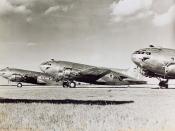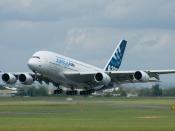For several decades the commercial airline manufacturing industry has been dominated by two major companies: Boeing and Airbus. There are a number of smaller aeronautical firms like Lockheed but none capable of building the large passenger planes that cost billions of dollars to develop and sell for hundreds of millions of dollars each. Because of these high costs, there is serious barrier to entry to any new competition and significant first mover advantage in the industry. For example, ÃÂit is costing Airbus $14 billion to develop its new super-jumbo jet, the 550 seat A380. To recoup the costsÃÂ Airbus will have to sell at least 250 A380 planes.ÃÂ (Hill 186) Because customers may only purchase 400 planes and the A380 was first to market, Airbus will most likely dominate the global marketplace in this category for many years to come.
Another unique aspect of the commercial aerospace industry is its long history of development subsidies (Hill 232.)
Boeing has received subsidies from the United States Government, the State of Washington, the State for Kansas, and receives numerous contracts from the US Department of Defense (DOD.) Airbus, on the other hand was originally started by a consortium of European companies (mainly British, German and French) in the 1960s, but is now a private company. Nevertheless, the EU continues to subsidize Airbus through low interest development loans, even though it has grown to be the leader in the industry.
Both Boeing and Airbus dislike the fact that their competition is getting an edge from these subsidies and think it is an unfair advantage. To level the playing field, in 1992 they entered into an agreement that limited the aid that they could receive from their respective governments. The EU was limited to funding Airbus with repayable launch aid of up to one-third...


